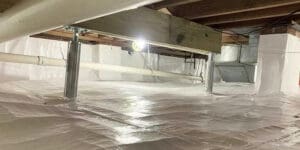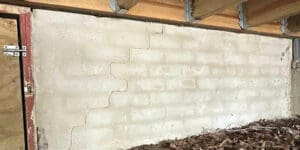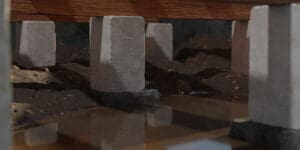Introduction to Crawl Space Moisture Control
Your crawl space may be out of sight, but it plays a massive role in your home’s health and your own. It is essential to keep this area dry and cozy, yet many people don’t think much about it. Let’s explore why this little space deserves attention, what can go wrong if neglected, and how to control the moisture levels to keep it in good condition.
Understanding Crawl Space Moisture
Sources of Moisture
Various factors can cause crawl space moisture, but the most common ones include drainage issues, leaking pipes, and inadequate ventilation.

If there are drainage problems around your home, groundwater may seep into the crawl space, resulting in standing water and high humidity. The ground around your home can absorb water like a sponge, leading to dampness in the crawl space.
Leaking pipes can also contribute to moisture in the crawl space, especially if they go unnoticed for extended periods.
Air carries moisture, and when it cools down, it turns back into water. The everyday activities in your home, like cooking, showering, and even breathing, add moisture to the air, which can end up in your crawl space. Inadequate ventilation can trap moisture in the crawl space, making everything damp and humid.
Consequences of Excess Moisture
Having a wet crawl space is like inviting trouble to dinner. Here’s what can happen:
- Structural Damage: Wood loves to drink up water, which is bad news for your home’s framework. This can cause wood rot, leading to a weakening of the structure from within. Similarly, metal is also susceptible to damage from water, as it can rust and corrode, further compromising the integrity of your home’s structure. So, taking measures to protect your home from water damage is crucial.
- Mold and Mildew: These unwelcome guests thrive in damp environments. They look and smell unpleasant and can cause respiratory and other health problems, especially for people with allergies or asthma.
- Bad Indoor Air Quality: The air from your crawl space doesn’t stay there; it moves into your living spaces. If that air carries moisture and mold spores, it can pollute your home’s air, which isn’t great for your residents.

Methods of Moisture Control
Vapor Barriers
Installing vapor barriers is a common and effective method to prevent ground moisture from entering the crawl space. Think of these as raincoats for your crawl space. They’re big plastic sheets that cover the ground and stop moisture from the earth from getting into the air. It’s a simple yet effective way to keep things dry.
Dehumidifiers
Dehumidifiers are helpful devices that help maintain optimal humidity levels in your home, thus preventing moisture-related issues. They work similarly to vacuum cleaners, but instead of picking up dirt and dust from the floor, they suck in the air, remove excess moisture, and then blow the dry air back out. Keeping a dehumidifier in your crawl space can better control the humidity levels, making it a less hospitable environment for mold and mildew to grow. It is the best tool to run to absorb moisture and keep it at an optimal level.
Sump Pumps
In areas prone to flooding or with high groundwater levels, sump pumps are essential for removing water from your crawl space. They pump out water collected in crawl spaces, preventing water damage and flooding. If standing water is a common problem for your crawl space, a sump pump with a battery backup will soak up all that water and drain it away, keeping moisture under control.
Step-by-Step Guide to Crawl Space Moisture Control
Step 1: Assess the Situation
The first step is to assess the extent of moisture in your crawl space and identify the primary sources of water intrusion. Take a flashlight and examine the area under your house. How moist is your crawl space, and where could the water come from? This phase is crucial in determining the appropriate methods to combat moisture.
Side Note: If the thought of going into your crawl space makes you uneasy because you think of it as a dark, wet place full of creepy crawlies (we get it!), we provide complete crawl space encapsulation as a service that will transform your crawl space into a clean, healthy space. As part of our warranty for full encapsulations, we perform annual maintenance and inspection of the crawl space, so you don’t have to worry about doing it yourself.
Step 2: Choosing the Right Solution
Choose the most appropriate moisture control methods tailored to your situation based on the assessment. Decide which tools and techniques will best suit your circumstances based on what you find. Depending on the condition of your crawl space, you may need a vapor barrier or a dehumidifier; sometimes, a sump pump may be the optimal solution. Remember that customization is necessary to achieve optimal results.
Step 3: Installation and Action
Whether installing a vapor barrier, setting up a dehumidifier, or placing a sump pump, ensure the installation process is carried out correctly for maximum efficiency. Get those solutions in place. A little effort here can save you a lot of trouble later on.
Preventive Measures to Keep Moisture Under Control
Routine Inspections
Regularly inspect your crawl space for any signs of moisture or damage to prevent minor issues from becoming major problems. Keep an eye out for leaks, check your moisture barriers, and ensure that your dehumidifier and sump pump (if you have them) work correctly.
Maintenance Tips to Keep Things Running Smooth
Maintain your moisture control systems to ensure they operate effectively, keeping your crawl space dry and healthy. Like any other part of your home, the systems you use to control moisture need a little TLC to keep them working their best. Clean your dehumidifier’s filter, check the sump pump’s operation before the rainy season, and repair any tears or damage to your vapor barrier.

The Importance of a Dry Crawl Space
Controlling moisture in your crawl space is more than just keeping your home’s structure safe; it’s about creating a healthier living environment for you and your family. Moisture accumulation can lead to many problems, but with the proper knowledge and tools, you can keep your crawl space dry and your home healthy. By understanding where moisture comes from, recognizing the potential issues it can cause, and knowing how to tackle it, you’re well on your way to maintaining a dry and comfortable home from the ground up.
Hopefully, you can tell that our team loves nothing more than helping out homeowners, contractors, and DIY enthusiasts alike. So, if you’re battling against moisture in your crawl space or want to ensure your home is in tip-top shape, we are here to help!
Have questions or need some advice? We’re just a phone call away. Let’s make your home a healthier, happier place together.




